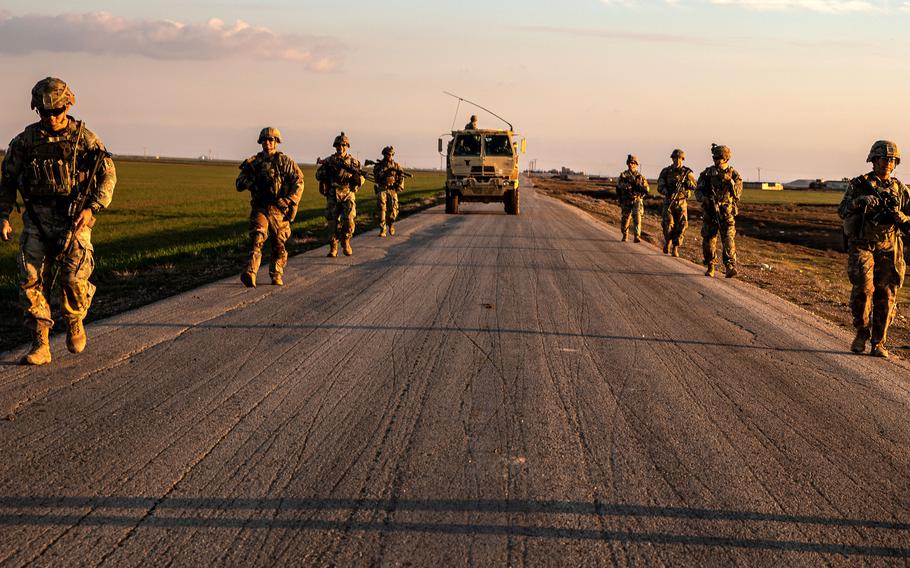
Soldiers of the 37th Infantry Brigade Combat Team patrol in Syria, Feb. 3, 2023. (Julio Hernandez/U.S. Army)
On Saturday, the U.S. Navy announced the presence of an attack submarine in the Persian Gulf to deter Iran from possibly launching attacks against Israeli-owned merchant vessels in retaliation for Israeli airstrikes against Iranian positions in Syria. The development came roughly a week after the George H.W. Bush Carrier Strike Group was ordered to stay in the Mediterranean Sea to support U.S. forces in the Middle East and about two weeks after F-15 fighters, on the orders of President Joe Biden, conducted airstrikes against Iranian-backed militias in eastern Syria in retaliation for a drone attack on a U.S. base in the country. One American contractor was killed and six other Americans were injured.
U.S. strikes in Syria against militia targets aren’t new. There have been at least four retaliatory strikes in Iraq or Syria during the Biden administration, all in response to rocket or drone attacks against U.S. personnel. The first occurred a little more than a month into Biden’s term, when rockets slammed into an air base in Irbil, Iraq, hosting U.S. forces, which wounded six Americans with the U.S.-led anti-ISIS coalition.
The rocket volleys and inevitable U.S. countermeasures have gotten almost routine. But amid the cycle, a baseline question is left untouched: Why is the U.S. military still in Syria anyway?
U.S. troops have been stationed in Syria across three consecutive administrations. In 2015, President Barack Obama deployed a small contingent of U.S. special operators and trainers to enable the U.S.-led military coalition against ISIS and assist Kurdish fighters who were proving highly effective on the ground. At the time, ISIS was ruling over significant chunks of Iraqi and Syrian territory — five months earlier, ISIS overran the Iraqi army in the city of Ramadi. In 2019, the year when ISIS’ territorial caliphate crumbled, the U.S. troop level was at approximately 2,000.
Today, the U.S. retains around 900 troops in Syria across a smattering of small facilities east of the Euphrates River. What tasks those troops are performing, however, depends on who you ask.
U.S. defense officials justify the U.S. presence in Syria as critical to the counterterrorism mission against the remnants of ISIS. But we must acknowledge that this is a dramatic change from the original mission. When U.S. troops were first deployed in-country, the objective was the elimination of the terrorist group’s territorial control, a goal that could be measured by looking at a map.
Today’s counter-ISIS mission, the “enduring defeat” of ISIS as an organization, is a noticeably more difficult one than taking back territory. Rarely do senior U.S. officials describe what they mean by “enduring defeat.” Does it mean eliminating every last ISIS terrorist in Syria? Does it mean, as Gen. Michael “Erik” Kurilla, commander of U.S. Central Command, suggested to the House Armed Services Committee on March 24, defeating the underlying ideology? If any of these descriptions do in fact apply, then the current U.S. mission is rubbing against goals that are unattainable — leaving the U.S. military trapped in Syria without an endpoint.
Some, such as William Roebuck, the former deputy special envoy for the anti-ISIS coalition, argue that the U.S. military presence in Syria is part of a broader policy objective: pushing the Syrian government into negotiations on a political transition. Because the U.S. and its Kurdish partners are occupying and administering the most energy-rich parts of Syrian territory, the argument goes, Washington can use its leverage to pressure Syrian President Bashar Assad toward fulfilling U.N. Security Council mandates.
Yet it’s Assad, not the Syrian opposition, that is being courted. The Syrian strongman is no longer a regional pariah, but a hot commodity in today’s Middle Eastern politics. Assad is greeting the Jordanian and Egyptian foreign ministers for talks at his residence, traveling to Oman for official discussions, and smiling with UAE President Sheikh Mohammed bin Zayed as if he were a long lost relative. Syria is in discussions with Saudi Arabia, previously one of its biggest adversaries in the region, on normalization. Given recent political developments, it’s hard to see the U.S. troop presence providing much leverage at all.
Still another justification, articulated by former Trump administration Syria envoy James Jeffrey, is preventing a strategic victory for Iran or compelling a full Iranian withdrawal from the country. But there are two problems with these goals. First, this is not a mission Congress has debated, let alone authorized and appropriated funds for. Second, this is the foreign policy equivalent of swimming upstream at a 90-degree angle. Iran has had a strategic relationship with the Assad government for more than 40 years; maintaining this relationship is a fundamental part of its foreign policy in the Middle East, allowing Tehran to project power and influence in a region composed of Arab states wary or adversarial of Iranian intentions. Syria is more important to Iran than it is to the U.S., so the notion Washington can coax an Iranian departure is the epitome of hubris and wishful thinking.
Commenting on last week’s drone attack in Syria, White House national security spokesman John Kirby declared that U.S. troops weren’t going anywhere. If U.S. policymakers could come up with a plausibly convincing case as to why the current U.S. military presence is absolutely necessary for its own security, then such words would be reassuring. But ever since ISIS’ caliphate collapsed, whatever case there was is no longer there.
Daniel R. DePetris is a fellow at Defense Priorities and a foreign affairs columnist at the Chicago Tribune and Newsweek.